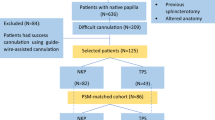Abstract
Background
In endoscopic retrograde cholangiopancreaticography (ERCP) difficult cannulation is an independent risk factor for complications.
Methods
Altogether 6,209 ERCPs were performed in Helsinki University Central Hospital in the period 1996–2006. In 558 cases (9%) without a previous sphincterotomy, direct access into the biliary duct could not be achieved. In this group access was attempted by first performing a pancreatic sphincterotomy in 351 difficult cannulation cases (63%). A needle knife precut without a pancreatic sphincterotomy was performed in 178 cases (32%). All the necessary clinical and laboratory information was available for 262 of the 351 patients who had undergone a pancreatic sphincterotomy and for 157 of the 178 patients who had been subjected to needle knife precutting, and these data were further evaluated in this study.
Results
The pancreatic sphincterotomy technique was successful in 255 cases (97.3%). Post-ERCP pancreatitis developed in 8.8% of the pancreatic sphincterotomy group. In 147 patients, biliary cannulation was successful following a pancreatic sphincterotomy, and the post-ERCP pancreatitis rate for those patients was 9.3%. In 108 patients, a needle knife papillotomy, in addition to a pancreatic sphincterotomy, was necessary and resulted in a post-ERCP pancreatitis rate of 8.2%.
In the needle knife precut group only, post-ERCP pancreatitis developed in 5.1% of cases. Biliary cannulation succeeded less frequently following needle knife precutting than following the pancreatic sphincterotomy technique (71.3% versus 97.3%, p < 0.001). There was no significant difference in the post-ERCP pancreatitis rate between the precut and pancreatic sphincterotomy techniques (p = 0.16).
Conclusions
In difficult cannulation, a pancreatic sphincterotomy to achieve deep biliary duct cannulation can be performed with a high success rate (failure rate less than 3%). The corresponding success rate using the needle knife precut technique is 71%. In both methods the risk for post-ERCP pancreatitis is comparable to that of a standard biliary sphincterotomy.
Similar content being viewed by others
Abbreviations
- EPT:
-
Endoscopic papillotomy
- ERCP:
-
Endoscopic retrograde cholangiopancreaticography
References
Freeman M, Guda N (2005) ERCP cannulation, a review of reported techniques. Gastrointest Endosc 61:112–125
Freeman M, Nelson D, Sherman S, Haber G, Herman M, Dorsher P, Moore J, Fennerty M, Ryan M, Shaw M, Lande J, Pheley A (1996) Complications of endoscopic biliary sphincterotomy. N Engl J Med 26:909–918
Freeman M (2002) Adverse outcomes of ERCP. Gastrointest Endosc 56(6 Suppl):S273–282
Cortas G, Mehta S, Abraham N, Barkun A (1999) Selective cannulation of the common bile duct: a prospective randomized trial comparing standard catheters with sphincterotomes. Gastrointest Endosc 50:775–779
Schwacha H, Allgaier H, Deibert P, Olschewski M, Allgaier U, Blum H (2000) A sphincterotome-based technique for selective transpapillary common bile duct cannulation. Gastrointest Endosc 52:387–391
Freeman M, DiSario J, Nelson D, Fennerty M, Lee J, Bjorkman D, Overby C, Aas J, Ryan M, Bochna G, Shaw M, Snady H, Erickson R, Moore J, Roel J (2001) Risk factors for post-ERCP pancreatitis: a prospective, multicenter study. Gastrointest Endosc 54:425–434
Vandervoort J, Soetikno R, Tham T, Wong R, Ferrari A, Montes H, Roston A, Slivka A, Lichtenstein D, Ruymann F, Van Dam J, Hughes M, Carr-Locke D (2002) Risk factors for complications after performance of ERCP. Gastrointest Endosc 56:652–656
Demling L (1983) Papillotomy—indications and technique. Endoscopy 15(1 Suppl):S162–164
Loperfido S, Angelini G, Benedetti G, Chilovi F, Costan F, De Berardinis F, De Bernardin M, Ederle A, Fina P, Fratton A (1998) Major early complications from diagnostic and therapeutic ERCP: a prospective multicenter study. Gastrointest Endosc 48:1–10
Masci E, Mariani A, Curioni S, Testoni P (2003) Risk factors for pancreatitis following endoscopic retrograde cholangiopancreatography: a meta-analysis. Endoscopy 35:830–834
Fuji T, Amano H, Harima K, Aibe T, Asagami F, Kinukawa K, Ariyama S, Takemoto T (1985) Pancreatic sphincterotomy and pancreatic endoprosthesis. Endoscopy 17:69–72
Goff J (1995) Common bile duct pre-cut sphincterotomy: transpancreatic sphincter approach. Gastrointest Endosc 41:502–505
Lempinen M, Stenman U-H, Halttunen J, Puolakkainen P, Haapiainen R, Kemppainen E (2005) Early sequential changes in serum markers of acute pancreatitis induced by endoscopic retrograde cholangiopancreatography. Pancreatology 5:157–164
Akashi R, Kiyozumi T, Jinnouchi K, Yoshida M, Adachi Y, Sagara K (2004) Pancreatic sphincter precutting to gain selective access to the common bile duct: a series of 172 patients. Endoscopy 36:405–410
Catalano M, Linder J, Geenen J (2004) Endoscopic transpancreatic papillary septotomy for inaccessible obstructed bile ducts: comparison with standard pre-cut papillotomy. Gastrointest Endosc 60:557–561
Kahaleh M, Tokar J, Mullick T, Bickston S, Yeaton P (2004) prospective evaluation of pancreatic sphincterotomy as a precut technique for biliary cannulation. Clin Gastroenterol Hepatol 2:971–977
Kapetanos D, Kokozidis G, Christodoulou D, Mistakidis K, Dimakopoulos K, Katodritou E, Kitis G, Tsianos E (2007) Case series of transpancreatic septotomy as precutting technique for difficult bile duct cannulation. Endoscopy 39:802–806
Goff J (1999) Long-term experience with the transpancreatic sphincter pre-cut approach to biliary sphincterotomy. Gastrointest Endosc 50:642–645
Osnes M, Kahrs T (1977) Endoscopic choledochoduodenostomy for choledocholithiasis through choledochoduodenal fistula. Endoscopy 9:162–165
Tweedle D, Martin D (1991) Needle knife papillotomy for endoscopic sphincterotomy and cholangiography. Gastrointest Endosc 37:518–521
Kemppainen E, Hedström J, Puolakkainen P, Halttunen J, Sainio V, Haapiainen R, Kivilaakso E, Stenman U-H (1997) Increased serum trypsinogen 2 and trypsin-alpha 1 antitrypsin complex values identify endoscopic retrograde cholangiopancreatography induced pancreatitis with high accuracy. Gut 41:690–695
Author information
Authors and Affiliations
Corresponding author
Rights and permissions
About this article
Cite this article
Halttunen, J., Keränen, I., Udd, M. et al. Pancreatic sphincterotomy versus needle knife precut in difficult biliary cannulation. Surg Endosc 23, 745–749 (2009). https://doi.org/10.1007/s00464-008-0056-0
Received:
Revised:
Accepted:
Published:
Issue Date:
DOI: https://doi.org/10.1007/s00464-008-0056-0




